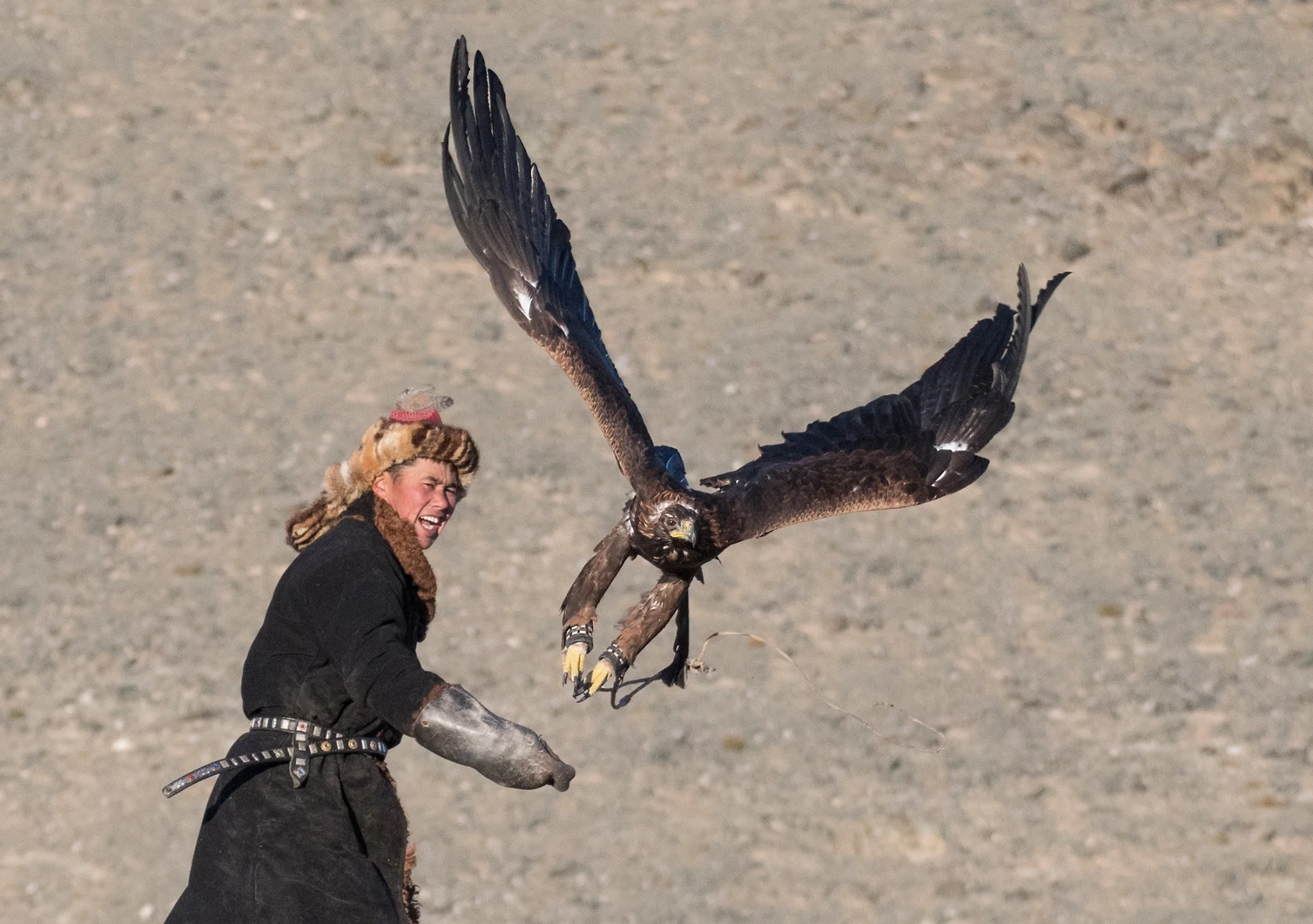Through the Eyes of the Eagle: Learning to See Differently with Mongolia’s Eagle Hunters
Out on the wind-blown ridges of western Mongolia, long before sunrise, the eagle hunters are already moving. Their breath clouds the air. Saddles creak. Somewhere above, a golden eagle shifts on its perch, eyes scanning the horizon with deadly calm. No urgency. Just readiness.
Watching them work, you begin to understand something essential—they’re not reacting. They’re anticipating. And for photographers, that’s the lesson.
This isn’t just a cultural experience. It’s a masterclass in patience, precision, and instinct.
The Bond Between Hunter and Bird
There’s a quiet language between the eagle and the hunter—built over years, not hours. Subtle cues. A shift in body weight. A glance. A sound only they seem to understand.
As photographers, we’re often taught to chase action. To fire off frames and hope something lands. But when you spend time with the eagle hunters, you learn the power of waiting. Of watching closely. Of reading behavior.
That’s how eagles hunt—and how we should photograph.
Seeing Like a Predator
Eagles don’t waste movement. They glide silently, survey from a distance, then strike with precision when the moment is right.
Photographing them teaches you the same approach. Instead of reacting to what’s already happened, you begin to sense what’s about to unfold.
You start noticing the small tells—when the bird's talons flex on the glove, or the hunter’s posture shifts ever so slightly. You see how a camel's head turns just before it breaks into a trot. How the dust moves under a horse about to charge.
The lesson? Slow down. Watch longer. Shoot later. And when you do, your images won’t just capture a moment—they’ll feel like they saw it coming.
Translating the Hunt Into Photography
Spending time with these families is more than an incredible cultural experience. It reshapes how you think about your craft.
You learn to choose your angle like a hunter picks his perch—downwind, with the sun at your back, looking toward where the action will be, not where it is now.
You start thinking in silence. You move less, but with more purpose. You stop over-directing your subjects and start engaging with them—letting their rhythm guide your shutter, not the other way around.
You stop photographing what something is, and start capturing how it feels.
Reflections from the Field
I’ve been photographing with these hunters for over a decade. They are not “photo ops.” They’re friends. I’ve seen their children grow, sat beside their fires, and watched how they prepare their birds with care, pride, and a level of dedication that humbles anyone watching.
And every year, I bring photographers here not just to take pictures—but to learn something deeper.
Some come for the thrill of photographing a golden eagle mid-flight. Others for the portraits of men in traditional dress on horseback, scanning the mountains like their ancestors did.
But most leave with something they didn’t expect—a shift in how they see. In how they wait. In how they approach their work, and the world.
Photo Tours Built on Trust: A Decade of Friendship
What makes this experience so powerful isn’t just the imagery—it’s the access. And that access isn’t something you can buy. It’s earned.
I’ve spent over a decade building relationships with the eagle hunting community in western Mongolia. These aren’t staged sessions with people paid to pose. These are friends—people who know me, trust me, and now welcome my guests with that same warmth and openness.
We’re invited into their homes—not as outsiders, but as guests. We sit around their fires, drink tea, share meals, and talk about everything from family to falconry. There’s no pretense. No performance. Just life, shared.
Because of that trust, we’re also invited to witness what most visitors never see: the training. Long before the tourist season begins, we join them in the mountains as they prepare their eagles for the winter hunting season. We’re there in the golden early light as they climb ridges, release their birds, and whistle commands that echo through the valley.
There’s no audience here. Just tradition—pure and unchanged for over 1,000 years.
And we’re not photographing strangers in costume. We’re photographing friends preserving a legacy.
Honored to Share Their Story
My connection to Mongolia runs deep.
Over the years, I’ve been fortunate to travel across the country many times—through its cities, steppes, and mountains—documenting the incredible diversity of its people and landscapes. But the eagle hunters of the Altai region have become like family.
In recognition of this work, I’ve been honored with two awards from the Mongolian government—citations of appreciation for promoting tourism, preserving culture, and sharing the story of Mongolia’s nomadic heritage with the world.
But the real reward isn’t framed on a wall—it’s in the moments I’ve shared with these families. In the quiet nods. The laughs over shared meals. The trust shown each time a hunter lifts his arm and releases his eagle, knowing we’ll photograph the moment with respect and care.
This is more than a photo tour. It’s a cultural exchange built on respect, history, and human connection.
Final Thoughts
Spending time with Mongolia’s eagle hunters will give you more than images—it will sharpen your eye, your timing, and your instincts.
Because when you start to see like an eagle—quiet, deliberate, and alert—you stop missing moments. You start anticipating them.
Join me in Mongolia for one of my Mongolia Photo Tours.




